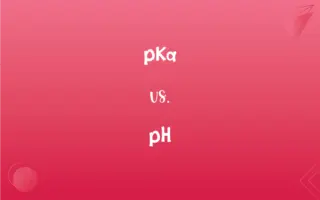Hexagonal Close Packing vs. Cubic Close Packing: What's the Difference?
Edited by Aimie Carlson || By Janet White || Published on April 21, 2024
Hexagonal close packing (HCP) arranges spheres in a repeating ABAB pattern, while cubic close packing (CCP) follows an ABCABC sequence.

Key Differences
Hexagonal close packing (HCP) and cubic close packing (CCP) are both ways to efficiently arrange equal-sized spheres in a three-dimensional space. HCP stacks layers of spheres in a hexagonal pattern, where every other layer is aligned. CCP, also known as face-centered cubic packing, arranges spheres in a cubic structure with layers following a three-layer sequence.
In HCP, the alignment of spheres creates a distinct hexagonal shape when viewed from above. Each sphere touches six others in its layer, and three in the layers above and below. In contrast, CCP forms a cubic lattice, with each sphere touching 12 others – six in its layer, and three each in the layers above and below.
The density of packing is a key difference. Both HCP and CCP achieve the highest possible packing density of 74%, but their structural arrangement differs. HCP's hexagonal arrangement results in a pattern repeating every two layers, while CCP's cubic structure repeats every three layers.
The applications of HCP and CCP vary based on their structural properties. HCP is common in metals like magnesium and titanium, prized for their strength and lightness. CCP is found in metals like copper and gold, known for their ductility and electrical conductivity.
The symmetries of HCP and CCP are distinct. HCP has a six-fold symmetry around its c-axis, reflecting its hexagonal arrangement. CCP exhibits a higher degree of symmetry due to its cubic structure, making it isotropic in nature.
ADVERTISEMENT
Comparison Chart
Pattern
Repeating ABAB sequence
Repeating ABCABC sequence
Shape
Hexagonal arrangement when viewed from above
Cubic lattice structure
Packing Density
74%, same as CCP
74%, same as HCP
Common Materials
Magnesium, Titanium
Copper, Gold
Symmetry
Six-fold symmetry around the c-axis
Higher degree of symmetry, isotropic
ADVERTISEMENT
Hexagonal Close Packing and Cubic Close Packing Definitions
Hexagonal Close Packing
Hexagonal close packing is a common arrangement in certain metal crystals.
Magnesium's lightweight nature is partly due to its hexagonal close packing of atoms.
Cubic Close Packing
Cubic close packing is known for its high symmetry and isotropic properties.
The cubic close packing in this material makes it equally strong in all directions.
Hexagonal Close Packing
HCP is characterized by its distinct hexagonal symmetry.
The hexagonal close packing contributes to the material's anisotropic properties.
Cubic Close Packing
Cubic close packing is prevalent in ductile and conductive metals.
Copper's flexibility and conductivity are due to its cubic close packing structure.
Hexagonal Close Packing
Hexagonal close packing is a compact arrangement of spheres in a hexagonal pattern.
In a crystal structure, atoms often adopt a hexagonal close packing for stability.
Cubic Close Packing
CCP is a lattice structure where each sphere is surrounded by 12 others.
Gold's excellent conductivity is attributed to its cubic close packing of atoms.
Hexagonal Close Packing
HCP is a lattice structure where each sphere is surrounded by six others in its layer.
The hexagonal close packing in this model illustrates how densely the atoms are arranged.
Cubic Close Packing
Cubic close packing arranges spheres in a cubic structure with a repeating ABCABC sequence.
The cubic close packing in this crystal creates a highly dense and uniform structure.
Hexagonal Close Packing
Hexagonal close packing repeats its pattern every two layers.
The hexagonal close packing found in this metal provides it with unique strength characteristics.
Cubic Close Packing
CCP achieves the highest packing density alongside HCP.
The dense arrangement of atoms in cubic close packing contributes to the material's durability.
FAQs
What is hexagonal close packing (HCP)?
HCP is an arrangement of equal-sized spheres in a repeating hexagonal pattern, common in certain metal crystals.
Are HCP and CCP structures found in nature?
Yes, both structures are commonly found in metal crystals and other natural formations.
What characterizes cubic close packing (CCP)?
CCP features spheres arranged in a cubic lattice, repeating in an ABCABC sequence, typical in metals like copper.
How does the packing density compare in HCP and CCP?
Both HCP and CCP achieve a maximum packing density of 74%.
What metals typically exhibit HCP?
Metals like magnesium and titanium often exhibit HCP due to their strong yet lightweight properties.
How does the symmetry differ between HCP and CCP?
HCP has a six-fold symmetry around its c-axis, while CCP has higher symmetry and isotropic properties.
Why is CCP significant in electronics?
CCP's structure, found in metals like copper, provides excellent electrical conductivity and ductility.
Do HCP and CCP have the same number of nearest neighbors?
Yes, in both structures, each sphere has 12 nearest neighbors.
How do HCP and CCP impact material properties?
The atomic arrangement in HCP and CCP influences the mechanical, thermal, and electrical properties of materials.
Can HCP and CCP be applied in engineering?
Yes, understanding these structures helps in material science and engineering, particularly in developing strong and durable materials.
How does temperature affect HCP and CCP structures?
Temperature changes can cause expansion or contraction in these structures, affecting material properties.
Can HCP and CCP be simulated computationally?
Advanced computational models are used to simulate and study HCP and CCP structures.
How does the study of HCP and CCP contribute to materials science?
It provides insight into material strength, flexibility, and other properties, aiding in the development of new materials.
Are HCP and CCP only relevant in metallurgy?
While important in metallurgy, these packing structures are also significant in crystallography and materials science.
Can HCP and CCP be observed under a microscope?
Yes, the atomic arrangements in HCP and CCP can be observed using electron microscopes.
Are HCP and CCP relevant in nanotechnology?
Yes, understanding these packing structures is crucial in designing nanoscale materials and devices.
Are there any limitations in using HCP and CCP for material design?
Certain materials may not easily form these structures, and their properties might vary under different conditions.
Can HCP transform into CCP under certain conditions?
Some materials can undergo phase transitions between HCP and CCP under specific temperature and pressure conditions.
Is HCP more common than CCP in nature?
The prevalence of each structure varies depending on the type of material and environmental conditions.
Are there any materials that exhibit both HCP and CCP?
Some alloys and compounds can exhibit characteristics of both HCP and CCP.
About Author
Written by
Janet WhiteJanet White has been an esteemed writer and blogger for Difference Wiki. Holding a Master's degree in Science and Medical Journalism from the prestigious Boston University, she has consistently demonstrated her expertise and passion for her field. When she's not immersed in her work, Janet relishes her time exercising, delving into a good book, and cherishing moments with friends and family.
Edited by
Aimie CarlsonAimie Carlson, holding a master's degree in English literature, is a fervent English language enthusiast. She lends her writing talents to Difference Wiki, a prominent website that specializes in comparisons, offering readers insightful analyses that both captivate and inform.





































































